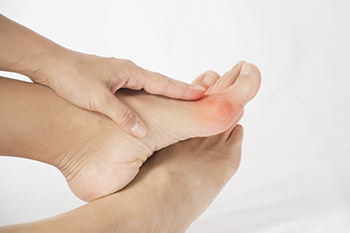Middlefield (860) 349-8500
Wallingford (203) 294-4977
Middlefield (860) 349-8500
Wallingford (203) 294-4977
 Bunions are a common foot deformity in which a bony bump slowly grows along the outside of the foot at the base of the big toe joint. Bunions can be painful, making walking and finding comfortable shoes particularly difficult. Conservative treatments such as resting and icing the foot and shoe modifications are usually the first line of treatment to address bunion symptoms and slow or prevent progression. However, surgery is also an option and can be used to relieve pain, improve foot stability, restore walking ability, improve the appearance of the foot, and prevent other deformities from developing. Whether or not you should consider surgery depends on the severity of the bunion, the impact that symptoms have on your daily life, and the presence of any other health conditions. To learn more about treatment options for bunions, please consult with a podiatrist.
Bunions are a common foot deformity in which a bony bump slowly grows along the outside of the foot at the base of the big toe joint. Bunions can be painful, making walking and finding comfortable shoes particularly difficult. Conservative treatments such as resting and icing the foot and shoe modifications are usually the first line of treatment to address bunion symptoms and slow or prevent progression. However, surgery is also an option and can be used to relieve pain, improve foot stability, restore walking ability, improve the appearance of the foot, and prevent other deformities from developing. Whether or not you should consider surgery depends on the severity of the bunion, the impact that symptoms have on your daily life, and the presence of any other health conditions. To learn more about treatment options for bunions, please consult with a podiatrist.
If you are suffering from bunions, contact Dr. Gordon Fosdick of Affiliated Foot Care Center. Our doctor can provide the care you need to keep you pain-free and on your feet.
What Is a Bunion?
A bunion is formed of swollen tissue or an enlargement of boney growth, usually located at the base joint of the toe that connects to the foot. The swelling occurs due to the bones in the big toe shifting inward, which impacts the other toes of the foot. This causes the area around the base of the big toe to become inflamed and painful.
Why Do Bunions Form?
Genetics – Susceptibility to bunions are often hereditary
Stress on the feet – Poorly fitted and uncomfortable footwear that places stress on feet, such as heels, can worsen existing bunions
How Are Bunions Diagnosed?
Doctors often perform two tests – blood tests and x-rays – when trying to diagnose bunions, especially in the early stages of development. Blood tests help determine if the foot pain is being caused by something else, such as arthritis, while x-rays provide a clear picture of your bone structure to your doctor.
How Are Bunions Treated?
If you have any questions, please feel free to contact our offices located in Middlefield and Wallingford, CT . We offer the newest diagnostic and treatment technologies for all your foot care needs.
Plantar fasci itis is the inflammation of the plantar fascia, which is the band of tissue that runs along the bottom of the foot from the heel to the toes. A common sign of plantar fasciitis is pain in the heel as well as the arch of the foot. The pain is usually worse when taking your first few steps right after sleeping or resting, and it may ease during exercise and worsen afterwards. Common risk factors for plantar fasciitis include exercising with a tight calf, recently starting to exercise on hard surfaces, wearing shoes with poor support, and being overweight. Patients who have heel pain that is stopping them from doing daily activities, that keeps getting worse, has not improved, or who also have diabetes should consult with a podiatrist for a proper diagnosis and treatment for the pain.
itis is the inflammation of the plantar fascia, which is the band of tissue that runs along the bottom of the foot from the heel to the toes. A common sign of plantar fasciitis is pain in the heel as well as the arch of the foot. The pain is usually worse when taking your first few steps right after sleeping or resting, and it may ease during exercise and worsen afterwards. Common risk factors for plantar fasciitis include exercising with a tight calf, recently starting to exercise on hard surfaces, wearing shoes with poor support, and being overweight. Patients who have heel pain that is stopping them from doing daily activities, that keeps getting worse, has not improved, or who also have diabetes should consult with a podiatrist for a proper diagnosis and treatment for the pain.
Plantar fasciitis can be very painful and inconvenient. If you are experiencing heel pain or symptoms of plantar fasciitis, contact Dr. Gordon Fosdick from Affiliated Foot Care Center. Our doctor can provide the care you need to keep you pain-free and on your feet.
What Is Plantar Fasciitis?
Plantar fasciitis is the inflammation of the thick band of tissue that runs along the bottom of your foot, known as the plantar fascia, and causes mild to severe heel pain.
What Causes Plantar Fasciitis?
How Can It Be Treated?
While very treatable, plantar fasciitis is definitely not something that should be ignored. Especially in severe cases, speaking to your doctor right away is highly recommended to avoid complications and severe heel pain. Your podiatrist can work with you to provide the appropriate treatment options tailored to your condition.
If you have any questions please feel free to contact our offices located in Middlefield and Wallingford, CT . We offer the newest diagnostic and treatment technologies for all your foot and ankle needs.
 Diabetes is a systemic condition, meaning that it can affect the entire body. One of the often overlooked parts of the body that diabetes can affect are the feet. People with diabetes are more likely to suffer from various foot conditions. Diabetes can cause nerve damage in the lower limbs and poor circulation. This combination of problems can lead to the development of poorly-healing foot wounds that are at risk of becoming infected. Other problems more common in diabetic feet include athlete’s foot and fungal nail infections, plantar warts, corns, calluses, cracked heels, blisters, ingrown toenails, hammertoes, and bunions. Inspecting your feet daily for any changes or abnormalities can help detect potential problems early, and seeking prompt treatment can improve your prognosis. If you have diabetes consult with a podiatrist, who can help you manage and maintain the health of your feet.
Diabetes is a systemic condition, meaning that it can affect the entire body. One of the often overlooked parts of the body that diabetes can affect are the feet. People with diabetes are more likely to suffer from various foot conditions. Diabetes can cause nerve damage in the lower limbs and poor circulation. This combination of problems can lead to the development of poorly-healing foot wounds that are at risk of becoming infected. Other problems more common in diabetic feet include athlete’s foot and fungal nail infections, plantar warts, corns, calluses, cracked heels, blisters, ingrown toenails, hammertoes, and bunions. Inspecting your feet daily for any changes or abnormalities can help detect potential problems early, and seeking prompt treatment can improve your prognosis. If you have diabetes consult with a podiatrist, who can help you manage and maintain the health of your feet.
Diabetic foot care is important in preventing foot ailments such as ulcers. If you are suffering from diabetes or have any other concerns about your feet, contact Dr. Gordon Fosdick from Affiliated Foot Care Center. Our doctor can provide the care you need to keep you pain-free and on your feet.
Diabetic Foot Care
Diabetes affects millions of people every year. The condition can damage blood vessels in many parts of the body, especially the feet. Because of this, taking care of your feet is essential if you have diabetes, and having a podiatrist help monitor your foot health is highly recommended.
The Importance of Caring for Your Feet
Patients with diabetes should have their doctor monitor their blood levels, as blood sugar levels play such a huge role in diabetic care. Monitoring these levels on a regular basis is highly advised.
It is always best to inform your healthcare professional of any concerns you may have regarding your feet, especially for diabetic patients. Early treatment and routine foot examinations are keys to maintaining proper health, especially because severe complications can arise if proper treatment is not applied.
If you have any questions please feel free to contact our offices located in Middlefield and Wallingford, CT . We offer the newest diagnostic and treatment technologies for all your foot and ankle needs.
 Sesamoiditis is a condition in which the sesamoids, two pea-shaped bones located beneath the big toe joint in the ball of the foot, are injured. Sesamoiditis is not visible to the naked eye, but can be diagnosed by a podiatrist. People with sesamoiditis typically feel a slow, steady onset of pain beneath the big toe. The pain tends to be worse when the foot is bearing weight and improves when the foot is elevated or at rest. The area directly beneath one or both sesamoid bones may be tender to the touch. The big toe will usually have a normal range of motion, but it may hurt to move it upwards. X-rays may be ordered to confirm the diagnosis and rule out other conditions, such as fractures, that can cause similar symptoms. If you suspect that you have sesamoiditis, please see a podiatrist for a proper diagnosis and treatment.
Sesamoiditis is a condition in which the sesamoids, two pea-shaped bones located beneath the big toe joint in the ball of the foot, are injured. Sesamoiditis is not visible to the naked eye, but can be diagnosed by a podiatrist. People with sesamoiditis typically feel a slow, steady onset of pain beneath the big toe. The pain tends to be worse when the foot is bearing weight and improves when the foot is elevated or at rest. The area directly beneath one or both sesamoid bones may be tender to the touch. The big toe will usually have a normal range of motion, but it may hurt to move it upwards. X-rays may be ordered to confirm the diagnosis and rule out other conditions, such as fractures, that can cause similar symptoms. If you suspect that you have sesamoiditis, please see a podiatrist for a proper diagnosis and treatment.
Sesamoiditis is an unpleasant foot condition characterized by pain in the balls of the feet. If you think you’re struggling with sesamoiditis, contact Dr. Gordon Fosdick of Affiliated Foot Care Center. Our doctor will treat your condition thoroughly and effectively.
Sesamoiditis
Sesamoiditis is a condition of the foot that affects the ball of the foot. It is more common in younger people than it is in older people. It can also occur with people who have begun a new exercise program, since their bodies are adjusting to the new physical regimen. Pain may also be caused by the inflammation of tendons surrounding the bones. It is important to seek treatment in its early stages because if you ignore the pain, this condition can lead to more serious problems such as severe irritation and bone fractures.
Causes of Sesamoiditis
Treatment for sesamoiditis is non-invasive and simple. Doctors may recommend a strict rest period where the patient forgoes most physical activity. This will help give the patient time to heal their feet through limited activity. For serious cases, it is best to speak with your doctor to determine a treatment option that will help your specific needs.
If you have any questions please feel free to contact our offices located in Middlefield and Wallingford, CT . We offer the newest diagnostic and treatment technologies for all your foot and ankle needs.
 When the feet become too dry, the skin on the heels can harden and crack. Cracked heels can be unsightly and uncomfortable. In some cases, the cracks can be deep, painful, and may even bleed. Treating and preventing dry, cracked heels begins with establishing a daily foot care routine. Soak the feet for at least 10 minutes in plain water and pat them dry, then gently rub your heels with a loofah to remove dead skin. Next, apply a thick moisturizer to the heels and put on cotton socks to seal in the moisture. If home treatments are not effective, it is suggested that you see a podiatrist for treatment.
When the feet become too dry, the skin on the heels can harden and crack. Cracked heels can be unsightly and uncomfortable. In some cases, the cracks can be deep, painful, and may even bleed. Treating and preventing dry, cracked heels begins with establishing a daily foot care routine. Soak the feet for at least 10 minutes in plain water and pat them dry, then gently rub your heels with a loofah to remove dead skin. Next, apply a thick moisturizer to the heels and put on cotton socks to seal in the moisture. If home treatments are not effective, it is suggested that you see a podiatrist for treatment.
Cracked heels are unsightly and can cause further damage to your shoes and feet. If you have any concerns, contact Dr. Gordon Fosdick from Affiliated Foot Care Center. Our doctor can provide the care you need to keep you pain-free and on your feet.
Cracked Heels
Cracked heels appear unappealing and can make it harder for you walk around in sandals. Aside from looking unpleasant, cracked heels can also tear stockings, socks, and wear out your shoes. There are several methods to help restore a cracked heel and prevent further damage.
How Do You Get Them?
Dry skin is the number one culprit in creating cracked heels. Many athletes, walkers, joggers, and even swimmers suffer from cracked heels. Age and skin oil production play a role to getting cracked heels as well.
Promote Healing
Over the counter medicines can help, especially for those that need instant relief or who suffer from chronic dry feet.
Wear Socks – Wearing socks with medicated creams helps lock in moisture.
Moisturizers – Applying both day and night will help alleviate dryness which causes cracking.
Pumice Stones – These exfoliate and remove dead skin, which allows for smoother moisturizer application and better absorption into the skin.
Change in Diet
Eating healthy with a well-balanced diet will give the skin a fresh and radiant look. Your body responds to the kinds of food you ingest. Omega-3 fatty acids and zinc supplements can also revitalize skin tissue.
Most importantly, seek professional help if unsure how to proceed in treating cracked heels. A podiatrist will help you with any questions or information needed.
If you have any questions, please feel free to contact our offices located in Middlefield and Wallingford, CT . We offer the newest diagnostic and treatment technologies for all your foot care needs.